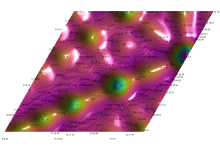Avoid note
In jazz theory, an avoid note is a scale degree considered especially dissonant relative to the harmony implied by the root chord, and is thus better avoided.
In major-key tonality the avoid note is the fourth diatonic scale step, or 11th, which is a minor ninth above the 3rd of the chord, and thus very harsh.[1] In melody it is usually avoided, treated as a "scale approach note"[2] or passing note,[3] or sharpened. It is not available in harmony. The available tensions for a dominant seventh chord are 9, ♯11, and 13.[1]
In minor harmony the sixth scale step is usually avoided, and the 13th is not regarded as an available tension.[1] The flat 13th lies a minor ninth above the fifth; however the reasons for avoiding it may lie more in avoiding subversion of the harmony by supplying the root of the major chord a third lower, e.g., altering Cm7 to A♭maj7/9.
In modal terms, the available scale steps of the mode (or available tensions for the chords) of the diatonic scale steps are those a whole step above the chord tones, and the avoid notes are those that are not. The only exception is the Dorian mode of the second scale degree, where the sixth is avoided although it is a whole step above the fifth; this is because the tritone between this and the third scale step would give an unwanted dominant flavor.[2] Taking C major as an example, the avoid notes are:[2]
| Scale degree | Chord | Mode | Avoid note | Available tensions |
|---|---|---|---|---|
| 1 | Cmaj7 | Ionian | Fourth scale step, F | 9, 13 |
| 2 | Dm7 | Dorian | Sixth scale step, B | 9, 11 |
| 3 | Em7 | Phrygian | Second and sixth scale steps, F and C | 11 |
| 4 | Fmaj7 | Lydian | No avoid note | 9, ♯11, 13 |
| 5 | G7 | Mixolydian | Fourth scale step, C | 9, 13 |
| 6 | Am7 | Aeolian | Sixth scale step, F | 9, 11 |
| 7 | Bø7 | Locrian | Second scale step, C | 11, ♭13 |
In his modal approach to minor harmony Haerle[4] does not use the term avoid note, but discusses "intolerably dissonant" notes and how they should be resolved. For the melodic minor scale he gives these:
| Scale degree | Chord | Mode | Avoid note | Available tensions |
|---|---|---|---|---|
| 1 | CmΔ | Ionian, ♭3 | No avoid note | 9, 11, 13 |
| 2 | Dm7 | Dorian, ♭2 | Second scale step, E♭ | 11, 13 |
| 3 | E♭augΔ | Lydian-augmented | Sixth scale step, C | 9, ♯11 |
| 4 | F7 | Lydian, ♭7 | No avoid note | 9, ♯11, 13 |
| 5 | G7 | Mixolydian, ♭6 | Either the fifth or sixth scale step, D or E♭ | 9, 11 |
| 6 | Am7/♭5 | Locrian, ♯2 | No avoid note | 9, 11, ♭13 |
| 7 | Bm7/♭5 | Super Locrian | No avoid note | (usually played as altered dominant) |
See also
References
- 1 2 3 Nettles, Barrie (1987). Harmony 1. Berklee College of Music. p. 34.
- 1 2 3 Nettles, Barrie (1987). Harmony 3. Berklee College of Music. pp. 15–17.
- ↑ Humphries, Carl (2002). The Piano Handbook (1st ed.). San Francisco: Freeman: Backbeat Books. p. 128. ISBN 0-87930-727-7.
- ↑ Haerle, Dan (1980). The Jazz Language: A Theory Text for Jazz Composition and Improvisation. Miami, Florida: Studio 224. ISBN 978-0-7604-0014-2.
